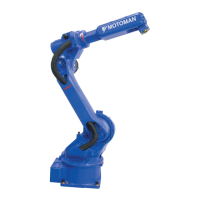4-11
168542-1CD
168542-1CD
MLX200 Software and
Operations
4 MLX200 Programming Guide
4.1 Developing a Simple Application
4.1.5.3 Summary
The following table provides a brief summary of how MLX will use the
Reference Position in different scenarios. Here are some basic guidelines
for using the Reference Position variables:
• If using taught positions, keep the TCP Position and the Reference
Position up to date if TCP Positions are modified/tweaked manually.
This can be done by re-teaching the points after any modifications
are made.
• If using TCP positions from an outside source (e.g. camera), set the
Reference Position to all-zero values for initial testing. In certain
cases (for example cable interference on the T-Axis), these values
will need to be further tweaked on an application by application
basis.
• Use Axis motions whenever strict linear motion is not necessary to
prevent issues with closures or redundant T-Axis positions.
Table 4-1: Summary of Reference Position Usage
Reference Position Result
5 or 6 Axis Robots Same closure as initial position, or
a closure switch that does not
prevent linear motion
Motion successful. Final axis
position will be equal to Reference
Position if from taught positions.
Closure switch from initial position
that prevents linear motion
Motion unsuccessful, alarm
displayed.
All-zero values Motion successful. Final axis
position will be in same “closure”
as initial position.
4 Axis Palletizing Robots Non-zero values Motion successful. Final T-Axis
position will be equal to T-Axis
position in Reference Position if
from taught positions.
All-zero values Motion successful. T-Axis position
will be T-Axis that results from
shortest rotational motion.

